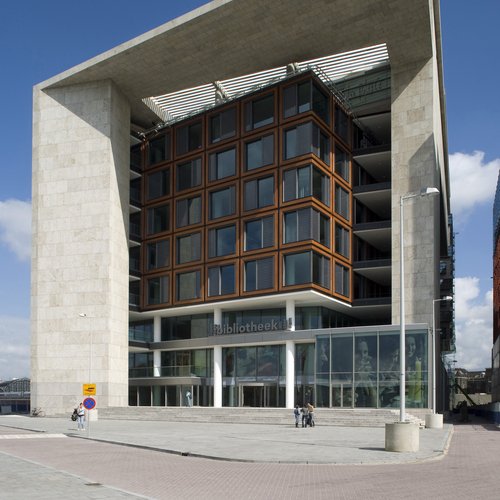Keeping it good and beautiful: Drainage system protects the fountain in front of the Old Opera from frost damage – permanently
Surrounded by magnificent historical buildings and a backdrop of modern skyscrapers: since the reopening of the Old Opera 35 years ago, on 18th August 1981, the opera square is a beloved meeting point in Frankfurt city. In the centre of the scene is the Lucae fountain, a fountain complex designed in accordance with old plans. But just a few years after its opening ceremony, the fountain was leaking. In the spring of 2010, it was renovated from the ground up. Gutjahr’s AquaDrain EK surface drainage found an unusual purpose: it supports the drainage of water before the winter break and protects from frost damage in the long term. Visitors will be convinced by seeing how it functions perfectly years after renovation.
Dip your feet into the beautiful fountain for a moment’s refreshment, while running your hand over the sun-warmed granite: that which made the Lucae fountain so attractive was no longer pleasurable to look at. Off-white debris has covered the fountain base, completely obscuring the original colour of the stone. The fountain was also losing more water than could be added: An obvious rivulet ran over the opera square. It could only be stopped by a total renovation down to the substrates - a general overhaul of technology and visuals was urgently needed.
Keeping floor covering
The mushroom shaped fountain system made of 120 tonnes of yellow gold Reinersreuth granite consists of a round basin and bowl supported by a pillar in the middle. At the first on-site appointment with the Frankfurt building authority and the contracted stonemason, E. Hennich, it was clear that the fountain base should still be made of 4 to 5 cm thick granite plating. As the laying mortar was damaged by frost, a draining substructure was proposed: in future, the water which has accumulated in the mortar can run off through the anti-capillary drainage system after the fountain has been emptied for the winter break. This drains the water accumulation which is inevitable during operation, preventing frost damage during the winter.
Drains faster
The water drainage capability improves up to 150 times with the capillary passive drainage mat beneath the drainage mortar – even when used in a fountain.
Image Gallery
A special challenge
Before the actual renovation could start, the fountain has to be dismantled piece by piece. When this took place, the heavy granite slabs were carefully disassembled and numbered, then the residual mortar was removed and the surface of the slabs was ground and polished. The pool of the fountain was to be re-engineered at the same time: To do this, the sloping concrete base was ground off completely and the foundation curbs to the edges were re-concreted. Unlike before, the concrete ring was given a reinforced connection to the substrate. Then the substrates of the pool including the technical shaft were sealed with several layers of a mineral sealing slurry.
A Gutjahr drainage mat was then laid onto the waterproofing to carry out a rather unusual task: because AquaDrain EK was actually specially developed for the laying of natural stone onto drainage mortar. In this special case it ensures that when the fountain is shut down in the winter, all water is removed from the mortar layer, which effectively avoids frost damage and efflorescence.
How AquaDrain EK works: The system is capillary passive, and supports the entire covering. Because of this, the drainage channels form a large cavity, and water can drain away more quickly and effectively. At the same time, backwater on the waterproofing no longer flows back into the covering structure, which avoids damage. Because of the back ventilation the covering also dries more quickly. Another special feature of this innovative system is the mesh, which remains permanently water-permeable, meaning that it does not clog because of the soluble lime in the drainage mortar. Gutjahr gives specialist companies a six-year guarantee on the system.
Beautiful Craftmanship
The Lucae fountain is once more the centre of many events around Frankfurt’s Opera square and has shone with its renovation for more than five years. The excellent work of the stonemasons is visible to all. Underneath, out of sight, everything is done to prevent damage from frost and water – and Gutjahr guarantees that it functions years after. Exactly that was the goal: retaining the beauty and functionality of the fountain. Thanks to the large pores of the laying mortar and the 16 mm tall drainage layer which is also installed, the water tha accumulates can be completely drained before the winter break. Walkers can therefore look forward to a refreshing foot bath in the summer. “Dem Wahren Schönen Guten” (to the True, the Good and the Beautiful): only the restored Lucae fountain may make use of the inscription on the moulding of the Old Opera, and justifiably so.
About the Lucae fountain
Like Frankfurter Opera House, now known as the Old Opera, the fountain was designed by Berlin architect Richard Lucae in 1872. The fountain complex was first brought to life in a slightly different form in 1983 by sculptor Edwin Hüller. The fountain system, made of 120 tonnes of Reinersreuth granite, consists of a round basin 17 metres in diameter and a bowl supported by a pillar for the water fountain. In 2010, the fountain was renovated from the ground up.
Gutjahr Products in use

AquaDrain® EK
The capillary passive surface drainage mat for fixed laying of natural stone coverings
![[TRL] Gutjahr Systemtechnik GmbH - Komplettsysteme für den Außen- und Innenbereich](/build/images/gutjahr-logo.d62773db.svg)





